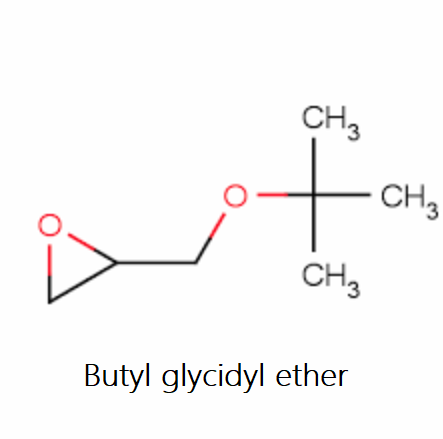The brief introduction of Butyl glycidyl ether
Jun 25,2024
Introduction
Butyl glycidyl ether (BGE) is the single epoxy group(ing) thinner of a kind of aliphatics of line style, comprises ether bond and epoxy group(ing) in the molecule, has the advantages such as viscosity is low, dilution effect is good; Participate in curing reaction during curing, form the homogeneous system, it is the epoxide resin reactive diluent of commonly used, can be widely used in the dilution of the epoxy materials such as solvent-free insulated paint, epoxy sealing encapsulating material, no-solvent type epoxy flooring coating and epoxy adhesive, wherein the elaboration fraction of high epoxy value also can be used as the material modified of other amine curing agents such as aliphatic amide, imidazoles.

Uses
BGE is used primarily as a reactive diluent for epoxy resins, as a viscosity-reducing agent, an acid acceptor for stabilizing chlorinated solvents, and as a chemical intermediate. BGE as Epodil® 741 is used as an epoxy resin diluent for tooling, electrical applications, flooring, and highly filled coatings. Additionally, it is used as an epoxy resin diluent in coatings, inks, adhesives, rubber, and plastics.
Synthesis method
A synthetic method of butyl glycidyl ether comprises the following steps of performing a ring-opening reaction on butanol and epoxy chloropropane to prepare a butyl chlorhydrin ether intermediate and performing a ring-closing reaction on the butyl chlorhydrin ether intermediate and sodium hydroxide to prepare a butyl glycidyl ether. The catalyst used in the ring-opening reaction is an active carbon-immobilized boron trifluoride catalyst, wherein the immobilized amount of boron trifluoride is 5-20%. Through using the active carbon immobilized boron trifluoride catalyst to catalyze the ring-opening reaction of butanol and epoxy chloropropane, the selectivity for the primary reaction of the ring-opening reaction is high. Side reactions are reduced so that the epoxide number of the obtained butyl glycidyl ether is high, the content of organochlorine is low, and the quality is good. In addition, the solid phase catalyst has low corrosion to devices, can be easily separated from reaction products after the ring-opening reaction, and can be recycled after being separated; therefore, environmental pollution is avoided.
Regulatory Status
The American Conference of Governmental Industrial Hygienists (ACGIH) time-weighted average (TWA) threshold limit value (TLV) is 25 ppm (135 mg/m3 ). NIOSH recommends a 15-minute exposure limit of 5.6 ppm (30 mg/m3 ). The OSHA eight-hour TWA permissible exposure limit (PEL) is 50 ppm (270 mg/m3 ) for BGE as an air contaminant in the general industry, as well as in shipyards and construction. The Environmental Protection Agency (EPA) regulates BGE under the Toxic Substances Control Act (TSCA) (e.g., 40 CFR 716.120). In 1992, BGE was added to the Master Testing List (MTL) under TSCA; testing action development was in progress.
- Related articles
- Related Qustion
Cuprous Oxide is a versatile and vital chemical compound with extensive applications in both industrial and agricultural settings.....
Jun 25,2024APIPralsetinib is a kinase inhibitor that targets wild-type RET and kinase-activated RET mutations and fusions.....
Jun 25,2024InhibitorsButyl glycidyl ether
2426-08-6You may like
- The toxicity of 2,2,4-Trimethyl-1,3-pentanediol monoisobutyrate.
Jul 17, 2024
- What is Hexachloroethane?
Jul 16, 2024
- The uses of 5-Aminolevulinic acid hydrochloride
Jul 15, 2024
Butyl glycidyl ether manufacturers
- Butyl glycidyl ether
-

- $100.00 / 1KG
- 2024-07-04
- CAS:2426-08-6
- Min. Order: 1KG
- Purity: 99%
- Supply Ability: 10000kg
- Butyl glycidyl ether
-

- $200.00 / 1kg
- 2024-04-24
- CAS:2426-08-6
- Min. Order: 1kg
- Purity: 99%
- Supply Ability: 20ton
- Butyl glycidyl ether
-

- $10.00 / 1kg
- 2024-04-23
- CAS:2426-08-6
- Min. Order: 1kg
- Purity: 99.6%
- Supply Ability: 100000





